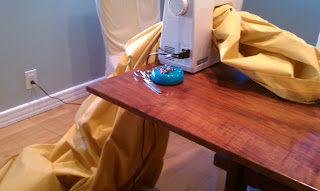Let me begin with a warning: do not do this. Or, okay, do it, but only if you really cannot afford a new couch. I should have just bought new furniture (yes, wasteful, but dear lord! Way easier). I guess if you are a great seamstress and have endless free time and no kids or no need to sit on the sofa in question for days and days then, sure, you can give it a go. Otherwise, seriously, Pottery Barn is your friend.
This is how 40 yards of 54" fabric is shipped to you from Fabric.com:
 |
| I'm only 5 feet tall. This is nearly a third of my body weight. Awkward isn't really strong enough of a word. |
If you follow any sort of "real" directions you will at this point be measuring out everything before cutting. The math worksheets inside "Custom Slipcovers Made Easy" ought to earn you college credit. At least a unit. Needless to say I did not do any of that. Instead, I followed the "Lazy Girl's Guide to Custom Slipcovers" and just did some draping and cutting.
Since the fabric is a solid color I just railroaded it which makes things much simpler. If this is your first slipcover (like me) DO NOT choose a pattern. Just don't. It is already enough work. Remember you want to drape the fabric inside out. The backside of my fabric is a bit lighter then how it will actually look.
Instead of draping the inside back all the way down onto the bench I put a seam between the bench and the inside back. My reason for doing this is that my bench could then drape all the way to the floor without a skirt. Ruffles aren't really my style. The important note here is that you have to make sure the bench piece is wide enough to wrap around the outside to meet with the side pieces (not in the above photo yet). You'll have to trim quite a bit around the inside arms, but it will be better then having to piece together yet another bit of fabric.
 |
| All these pins are wrong. Every single one. |
Here is a tip for beginners that ought to be tattooed on my face: RIGHT SIDES TOGETHER. I pinned across the back and along the inside arms before realizing I'd pinned it wrong. Yeah. That was rough. I was too busy trying to get it straight and tight. A stupid mistake that cost me a chunk of time. Another hint: you will pin your hands. It will hurt. Drink wine. It will help.
I used something like 300 pins. My fancy magnetic pin cushion was worth the investment. I love mine! I can't imagine what I would have been doing without it. Individually poking them into my standard tomato? No thanks.
"Lazy Girl's Guide" is skimpy on some details which becomes evident once you are trying to fit the fabric around curves and along angles. I had to make darts along the corners which wasn't difficult or anything- just wasn't in the directions. This is where the overwhelming detail and complicated techniques in the "Slipcovers Made Easy" book are helpful in pointing you in the right direction. Not that I was going to be doing faux-box corners or anything, but at least I knew I wasn't crazy that it wasn't looking right without the darts.
Another totally awesome tool to use when making your own welting or piping is this do-dad:
The do-dad is magnetic so sticks to the base plate and pushes the cording up along the zipper foot nice and tight. I have zero idea when or why I purchased it, or what it is really called, I just happened to find it among my notions while searching for my zipper foot and was pretty stoked I had it. It will also help you gather pins when you leave the magnetic pin cushion in the other room. FYI.
 | ||||
| I made 7.5 yards of finished welting. The whole process, cutting bias strips and sewing, took me about 3 hours. I will need to make an additional 20 yards for the cushions and then double the whole amount for the second couch. Yeah. That should be 10-12 hours of work I imagine. I then pinned the fronts to the arms inserting the welting along the seams. I cut into the arm drape where I wanted to run the welt horizontally across the side of the couch. That was unnerving since I'd already pinned the inside of the arm to the bench and inside back and was concerned I'd mess it up and have to re-do all the work. This eats up pins like crazy. After all the pinning it is finally time to sew. Now in "Lazy Girl's Guide" she bastes all the seams by hand before taking it to her machine. That sounded like a good plan to me so I tried it. Terrible. I don't know what I did wrong, but something was not right. I kept snapping the thread and was really burned out with the whole effort. I quit basting after one one arm. Maybe I should have taken a break. In "Sewing Made Easy" she doesn't baste, but does outline with marker where she wants the seams. The problem with that is you have to plan ahead of time how you intend to put the fabric through the machine which spatially I cannot do. Unless she was doing it on both sides of the future seam? Maybe that would have worked. Anyway, I said screw it and dragged the pinned mess to my dinning room.
This was difficult. And all kinds of disastrous. There is simply way too much fabric! A tip for beginners (that I will be using on the second slipcover): pin one seam at a time, sew, check the fit, then pin the next seam, sew, check the fit, repeat-repeat-repeat. It may seem more time efficient to pin all at once and then sew it all at once, which it may very well be, but don't do it if you don't know what you are doing. Completely exhausted, I turned it right side out and put it on the couch. It did not fit well and I had bunching where I'd sewn through two layers on accident in several places. I did not take a picture because I was pretty sure I was going to give up. Wish I had now. (Taken photos, not the giving up.) I talked myself into trying to fix it after a couple of days of moping. I had to rip out and re-pin a bunch of seams, all of them along the arms.
Part 2 will be the cushions and I hope to do them this week. We'll see how it goes with my time. And then, of course, I have to do the second couch. Good grief! |














nice tips in that article..i like that article...i can make some slip cover by my self in home..thanks
ReplyDeleteThe new cover is going to look great! I admire you for taking on such a big project!
ReplyDeleteWould love to see where you are on this project!
ReplyDeleteHere at Leather Repairs we can visit your home and carry out on site repairs to most stitching problems. Sometimes with normal wear a seam can burst open, leaving and unsightly look, if left pressure on the area could result in the leather tearing making a simple cost effective hand stitch repair become more costly, its best to catch it in the early stages.
ReplyDeleteYou are hysterical - loved your post! And I admire your sense of adventure. Like you, I sew avidly enough to sometimes bite off more than I can chew. I could see myself typing every bit of this. Thanks for posting it, it made me re-think my plans to try it myself - at least on the upstairs sofa. May try it out on the den basement first. ;-) Maybe you should write your own "Guide" - I'd buy, even if just for lifting my spirit while moping during a project. ~Laura
ReplyDelete